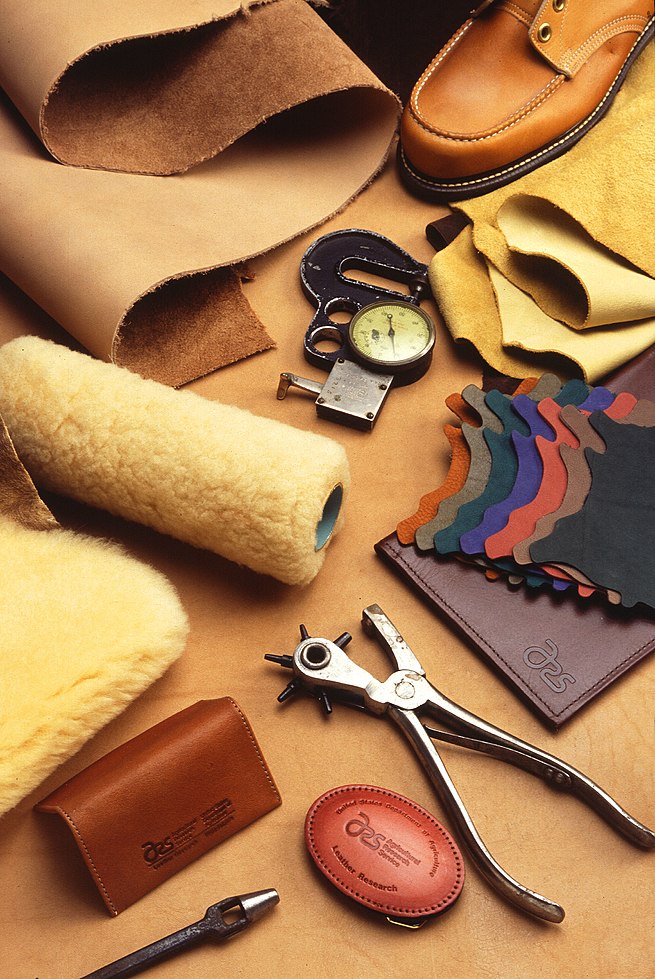
-
Rexine
Rexine is the registered trademark of an artificial leather leathercloth fabric produced in the United Kingdom by Rexine Ltd of Hyde, near Manchester, England. It was made of cloth surfaced with a mixture of cellulose nitrate (a low explosive also used as the propellant in firearms rounds), camphor oil, pigment and alcohol, embossed to look like leather.
Used as a bookbinding material and upholstery covering, Rexine was also widely used in trimming and upholstering the interiors of motor vehicles produced by British car manufacturers beginning in the 1920s, and the interiors of railway carriages, its cost being around a quarter that of leather. It was used by the British Motor Corporation in the 1960s and 1970s, particularly as a surface for ‘crash padding’ on dashboards and doors. It was also used for British teddy bear paw and foot pads from the late 1930s to early 1960s.
The author George Orwell, writing in his wartime diary on April 29, 1942, reported on his visit to the British House of Lords: “Everything had a somewhat mangy look. Red rexine cushions on the benches – I could swear they used to be red plush at one time.” The use of rexine in a railway carriage contributed to the rapid spread of fire on the 15:48 West Riding express from King’s Cross near Huntingdon on 14 July 1951
-
Leather
Leather is a natural durable and flexible material created by tanning animal rawhides and skins. The most common raw material is cattle hide. It can be produced at manufacturing scales ranging from artisan to modern industrial scale.
Leather is used to make a variety of articles, including footwear, automobile seats, clothing, bags, book bindings, fashion accessories, and furniture. It is produced in a wide variety of types and styles and decorated by a wide range of techniques. The earliest record of leather artifacts dates back to 2200 BC.
-
Rexine (noun)
A type of leather imitation, as used for things like book covers and upholstery.
-
Leather (noun)
A tough material produced from the skin of animals, by tanning or similar process, used e.g. for clothing.
-
Leather (noun)
A piece of the above used for polishing.
-
Leather (noun)
A cricket ball or football.
-
Leather (noun)
(plural: leathers) clothing made from the skin of animals, often worn by motorcycle riders.
-
Leather (noun)
A good defensive play
“Jones showed good leather to snare that liner.”
-
Leather (noun)
The skin.
-
Leather (adjective)
Made of leather.
-
Leather (adjective)
Referring to one who wears leather clothing (motorcycle jacket, chaps over 501 jeans, boots), especially as a sign of sadomasochistic homosexuality.
-
Leather (verb)
To cover with leather.
-
Leather (verb)
To strike forcefully.
“He leathered the ball all the way down the street.”
-
Leather (verb)
To beat with a leather belt or strap.
-
Rexine (noun)
an artificial leather, used in upholstery and bookbinding.
-
Leather (noun)
a material made from the skin of an animal by tanning or a similar process
“a leather jacket”
-
Leather (noun)
leather clothes, especially those worn by a motorcyclist
“he was dressed head to toe in black leathers”
-
Leather (noun)
a piece of leather as a polishing cloth.
-
Leather (noun)
short for stirrup leather
-
Leather (verb)
beat or thrash (someone)
“he caught me and leathered me black and blue”
-
Leather (verb)
strike or kick (a ball) very hard
“Carlos took his customary 20-metre sprint up to the ball and leathered it”
